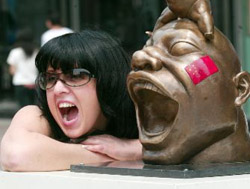
The Olympic spirit is taking shape in Wangfujing with the
installment of 290 landscape sculptures celebrating the ethos of
the games.
Droves of enthusiastic, camera-toting spectators are descending
on Beijing's high-end shopping strip to ooh and aah over the works,
pose for snapshots and cast votes for the work they believe
deserves the gold medal.
With the generation of such enthusiasm, the 2008 Olympic
Landscape Sculpture Exhibition doesn't only portray the Olympic
spirit - it's creating it.
The exhibition is one of 28 events featured during the 4th
Beijing 2008 Olympic Cultural Festival, which will draw to a close
on July 15.
The landscape sculpture exhibition will line the streets of
Wangfujing until Monday. On Tuesday, the exhibition will hit the
road on what is expected to be a 30-city tour, making its first
stop in Tianjin in a little more than a week from now.
From Tianjin, the exhibition will travel to Xiamen, Zhengzhou,
Changchun, Taiyuan, Shijiazhuang, Ningbo, Nanning, Shenzhen, Hong
Kong and Macao, as well as a number of major cities outside China
to be announced.
After the votes are tallied, the competition will conclude with
a televised awards ceremony in the fall of 2007, where 29 gold,
silver and bronze prizes (Beijing's Olympiad will be the 29th) will
be awarded to the sculptors with the most votes.
Most works highlight themes of international unity, dream
realization (in line with the Games' "One World, One Dream" slogan)
and the prospects of Beijing 2008. And in an exhibition where shape
serves as the lingua franca, one shape representing all of these
values dominates the conversation the Olympic rings.
While pervasive, the use of the rings is kept from becoming too
monotonous by the variety and creativity of the ways the Olympic
icon is used as a basis for the creation of other forms.
The rings sometimes appear in their traditional, stand-alone
form, but more often than not, the artists tried to challenge their
imagination to use them to form arms, legs, heads, pigtails, peach
blossoms, pillar tops and tunnels.
One of the best examples of such cleverness is "Dream
Realization," by He Jianjun of Guangdong Province. The interlocking
rings form the torsos or other parts of the body for five stainless
steel figures whose arms are thrust skyward in celebration. But
they also serve as negative space between the figures.
The rings become metallic wings for three competitive runners in
Beijing artist Meng Zhao's "Olympic Wings," suggesting the Games'
giving flight to hope. The metaphor is somehow less impressive, not
the kind of thing that will make observers say "wow," not like
"Dream Realization."
Figurines join hands to create interlinked loops coloured the
respective blue, yellow, black, green and red of the Olympic rings
in Yunnan artist Yang Xiaobo's "The World Is a Family." The idea is
to portray how the Games foster increased interconnectedness of
different people around the globe and succeeds on that level,
although the craftsmanship seems too primitive.
While sculptors from 56 countries contributed to the exhibition,
the cultural essence of the subject matter is principally but not
overwhelmingly Chinese.
Traditional themes involving dragons, martial arts fighters and
drummers and dancers abound, but the styling is overwhelmingly
contemporary.
One of the more striking pieces of paradox is "New Beijing, New
Starting Point," by Beijing artist Liu Bolin. It shows a terracotta
warrior poised in a race-takeoff stance, possibly representing the
way Beijing is dashing into a new era since its selection as the
2008 host city.
"Kung Fu Soccer," by Fujian artist Chun Lin, features a Chinese
man in traditional garb administering a high kick to a soccer
ball.
More abstract pieces allude to other facets of Chinese culture
and heritage.
The stainless steel work, "Celebration of 'Ren,'" by US artist
Markt Weisbeck, takes the Chinese character for the word "people"
into the third dimension by sculpting the character's two concave
baselines, which join at the top. It's a bold execution of a
simplistic form.
A few other foreign works focusing on internationalism with a
spotlight on China are worthy of note, such as Asherah Cinnamon and
Scott Fuller's "Reaching for Courage The Gateway to China," in
which several tiny figurines walk through a series of red, art
nouveau-style archways, and the more abstract "China and the World
Embrace in the Olympic Spirit" by Puerto Rican artist Celia
Rodriguez, which shows red and blue folded trapezoids linked by a
blue spiral.
The 290 works on display represent what organizers are calling
the best of the 2,433 pieces entered by more than 1,000 sculptors
from 81 countries.
The exhibition, therefore, can boast a particular honor as the
largest manuscript solicitation for sculptures in Olympic
history.
Perhaps the most accessible exhibition of the cultural festival
yet, the landscape sculpture exhibition is worth a visit for those
hoping to whip their Olympic spirit into shape.
(China Daily July 3, 2006)
|

